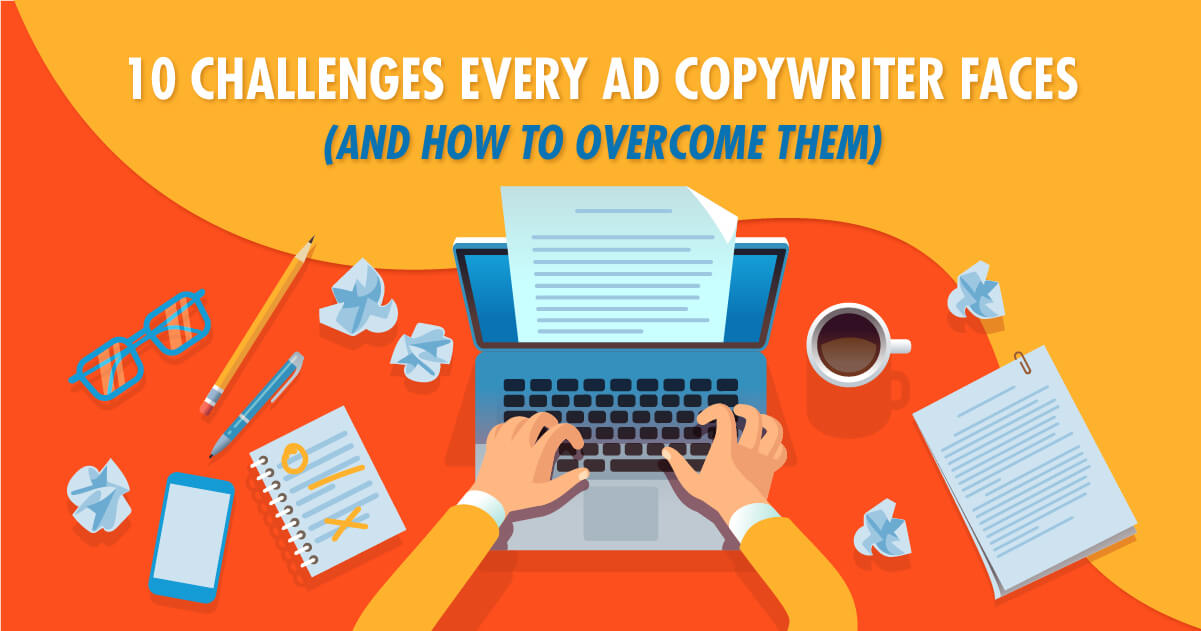15 Jul

Think back to a time when you saw an ad on social media that made you purchase a product or service. What is it about the ad that convinced you? And more importantly, how did the ad capture your attention and sustain your interest? Whatever your answer is, there’s a big chance it’s the ad copywriter’s creative chops that led you to be a customer. If you’re not familiar with ad copywriting, you’ve come to the right place! In this article, we’ll discuss what an ad copy is and what goes into writing one. We’ll also look at the common challenges an ad copywriter has and how to overcome them.
What is Ad Copywriting?
Before we dive further into the subject, first things first. What is copywriting in marketing, and what is ad copywriting? Basically, this entails creating written content for an ad. Copywriting involves understanding the campaign and creating a bridge that will lead the audience to support the brand.
The way you craft your ad copies is essentially significant. In fact, a study shows that headlines alone can immensely affect the impact of an ad.
Advertising Copywriter Job Description
If you look at visual ads, both online and offline, all the written elements such as taglines, slogans were created by advertising copywriters. In the same vein, the ad copywriter is also responsible for creating scripts in the case of video and audio.
Here are some of the typical materials produced by a copywriter:
- Copy for print ads in newspapers and magazines
- Scripts for broadcast ads in television and radio
- Copy for online advertising platforms, such as Facebook ads, Google ads, etc.
- Ad copy for outdoor ads such as billboards, brochures, flyers, etc.
Crafting content meant to lure the audience in – sounds exciting, right? However, just like any other creative job, it comes with its own set of challenges.
10 Challenges an Ad Copywriter Faces

Here are ten challenges you must be ready to face if you’re planning to take on the task.
1. Procrastination
This challenge doesn’t only apply to an ad copywriter but to any writer in general. It’s easy to start writing only to be distracted by something you see online or an exciting show playing on TV. Before you know it, the day is done, and you still have a blank page.
Solution: One solution to discourage yourself from procrastinating is to set up a timer. There are many great apps online that will allow you to clock in and out for every task. As a result, you’ll have a clear picture of how you’re spending your time and push you to be time-efficient.
2. Not Enough Inspiration
There are times when words just won’t come to you. You want to get started, but you don’t know how to. One possible reason why you’re not inspired to write about something is that you’re not familiar with the topic. If you’re usually writing an ad copy for food products, it could be uninspiring to create one for a financial app.
Solution: Research and read about the topic. Usually, the more you know about the topic, the more interested you become.
3. Difficult Clients
Not all clients are easy to work with. Heck, some clients don’t even know what they want! It may feel like they want one thing during the brainstorming session, but do a 360-degree turn on your next meeting.
Solution: Communication is key. Ask questions if the brief isn’t clear enough. In addition to that, summarize everything before every meeting is done. By doing so, you can make sure you’re on the same page.
4. Not Enough Confidence
Whether you’re an email copywriter or a web content writer, confidence can always be a challenge, especially at the start. You feel like you’re not good enough, and you tend to feel insecure when you read other writers’ stunning pieces of work.
Solution: Confidence comes with time. If you feel like you’re not good enough, use that to push yourself to study harder, read more, and focus better when you’re writing. Writing is a skill, and you can always improve how you do it.
5. Fierce Competition
Reading copywriting examples is enough to make you see how stiff the competition is out there. It’s hard to be noticed when you’re against big wigs.
Solution: Build a strong portfolio that shows your brand as a writer. After all, copywriting isn’t about being the best but presenting a unique perspective the audience could relate to.
6. Can’t Get Traction
Just like with website copywriting, it can get a little frustrating if your work isn’t getting enough results. If your ad copy isn’t converting, it’s easy to feel like a failure and get disheartened.
Solution: Treat every non-converting copy as a lesson. Do an A/B test. What works and what doesn’t? This is the part of copywriting where science and analysis are as crucial as art and creativity.
7. Unfamiliarity with the Niche
It would be fairly difficult to write a copy that convinces someone to buy a product when you don’t even have any idea what it is.
Solution: Think like the target market. What is important to them, and how can you make the product sound so good, they won’t have any choice but to buy?
8. Isolation
Writing is a solitary activity. And sometimes, spending a lot of time with your computer can make you crave social interaction.
Solution: Meet your family or friends! Or if time doesn’t permit a trip to the coffee shop, chat up someone dear to you.
9. Out of Touch With the Audience
If you look at the best copywriting ads, you’ll see that they use the same unique voice as their audience. But what if you don’t have any idea about how they think?
Solution: One way to get an idea about your audience’s frame of mind is by visiting online forums where they usually are. What do they talk about, and what are their concerns? Spy a bit to understand where they’re coming from.
10. Writer’s Block
This is another challenge familiar to any person trying to produce words. Sometimes, it just doesn’t flow out of you.
Solution: One possible solution is to get away from your desk and read. As they say, you can’t create if you don’t consume. In addition to that, you can also take inspiration from how famous writers got over their writer’s block. For instance, Mark Twain created an outline to push himself to get started. On the other hand, Neil Gaiman puts his writing aside for a while so that he’ll have a fresh perspective when he comes back to it.
Conclusion
In conclusion, being an ad copywriter entails performing many layers of tasks – from technical research to producing creative pieces that hook the audience in. And as illustrated above, it can be a challenging job, to say the least.
The great thing is, you don’t have to do it yourself. If you don’t have the time to learn the ropes, you can find a copywriter who can do it for you. Not only will you get a professionally-crafted piece, but you’ll also have more time to focus on more crucial parts of your venture.
Like what you read? Share this post on social media!










